Roughly 33% of individuals who receive newsletters from companies end up buying something from them at least once per year. So no wonder that – with an average ROI of $ 42 per every $1 spent – email marketing is one of the most effective ways of communicating with your potential customers.
Succeeding in email marketing depends on a lot of factors – you can’t just send a couple of newsletters and expect money to start pouring in. So in this post – we are going to explain how to create an effective B2C email marketing strategy (if you have a B2B business – read our post on creating a successful B2B email marketing strategy here!)
How to create a B2C email marketing strategy in 6 simple steps?
STEP 1: Understand the nature of B2C email marketing vs. B2B
B2C email marketing aims at convincing individuals to buy goods or services for their personal use.
This means consumer goods, clothes, make-up, food, experiences such as trips, dinners, nights out, and activities, presents, leisure, and wellness.
Understandably: when we buy things for ourselves rather than our businesses, the purchasing decisions are based on different criteria:
- perceived value & how the purchase makes us feel – rather than price, we think of how much value we will get out of the purchase
- brand loyalty – while brands matter a lot less in B2B, and we tend to make more calculated and rational decisions, brand loyalty plays a big role in B2C consumer choices – after all, certain brands exude certain values – e.g. comfort, luxury, independence, success – that we want to identify with
- emotions rather than features – while you may be making calculated decisions when buying e.g. software for your business, when purchasing goods like clothes, make-up, or presents – you will think of how the purchase will make you look and feel rather than specific features of the product; we also tend to make more irrational and impulse choices when shopping for ourselves: e.g. ‘This will look great on me!‘, ‘I have had a bad day, this will cheer me up‘; ‘I’ve worked so hard this year – I deserve it;’
Advertisements of perfumes are a great example of B2C marketing – they often exploit stereotypes to evoke basic human instincts and feelings of desire etc.
So – how can you use this for your newsletters?
Make sure they also appeal to these sentiments – evoke emotions, focus on building relationships, and brand loyalty, and evoke desire. You can best do it by telling compelling stories.
The trick that always works in B2C email marketing – discounts
Discounts are one of the strongest motivations why consumers subscribe to B2C newsletters: 42.3% of Americans say they subscribe to newsletters to receive discounts, and 62% complete purchases if they get personalized discount vouchers:
So – doing the maths – to make your B2C email marketing effective you should:
- appeal to your recipients’ desires and emotions
- offer them exclusive, personalized discounts (that’s how you get them to sign up to your email list in the first place – make sure the discounts for your subscribers are unique and are not available elsewhere!) – send them time-sensitive discount vouchers
STEP 2: Know your audience

But how can you appeal to your audiences’ emotions or personalize your discounts to them if…you don’t know them?
That’s right: the first step is to really understand your audience well and customize your emails to their needs.
Personalized emails on average result in revenues 6 times higher than generic ones.
How to personalize your B2C newsletters?
- Make sure you segment your list by age, gender, etc. – you should collect this information through your newsletter signup forms or in a follow-up survey
- Segment your audience by their interests – have different lead magnets (downloadable assets – e.g. PDFs with useful tips, recipes, calendars – depending on your target audience and product of course!) on different blog posts, and segment your list by the interests that were made evident by what your audience downloaded in the first place.
STEP 3: Collect your subscribers
Before you send your newsletters, you need to…have someone to send them to.
Here are some quick ways to grow your email list:
- Ask your customers for permission to send them newsletters with each purchase
- Embed signup forms in all your blog posts
- Use popups and exit-intent popups for collecting signups
- Create downloadable lead magnets
- Ask for emails at events and on social media
Wanna know how to collect your subscribers? Visit our earlier post here.
STEP 4: Think about what you want to write – B2C email marketing campaign content plan
The content of your B2C email marketing depends on the reason why you send your newsletters – so the triggering event: e.g. abandoned cart in your e-commerce store, download of a lead magnet, or subscription via a sign-up form on your website or blog.
So – the starting point is thinking about how you’re gonna start the conversation with your new subscriber, and then – how you’re gonna follow it up. And the follow-up really matters – if you send 3 ‘abandoned cart’ emails – this will result in 69% more purchases (on average) than if you send only one.
Here is an example of a few possible scenarios of B2C email marketing campaigns with different starting points:
1. Abandoned Cart Campaign
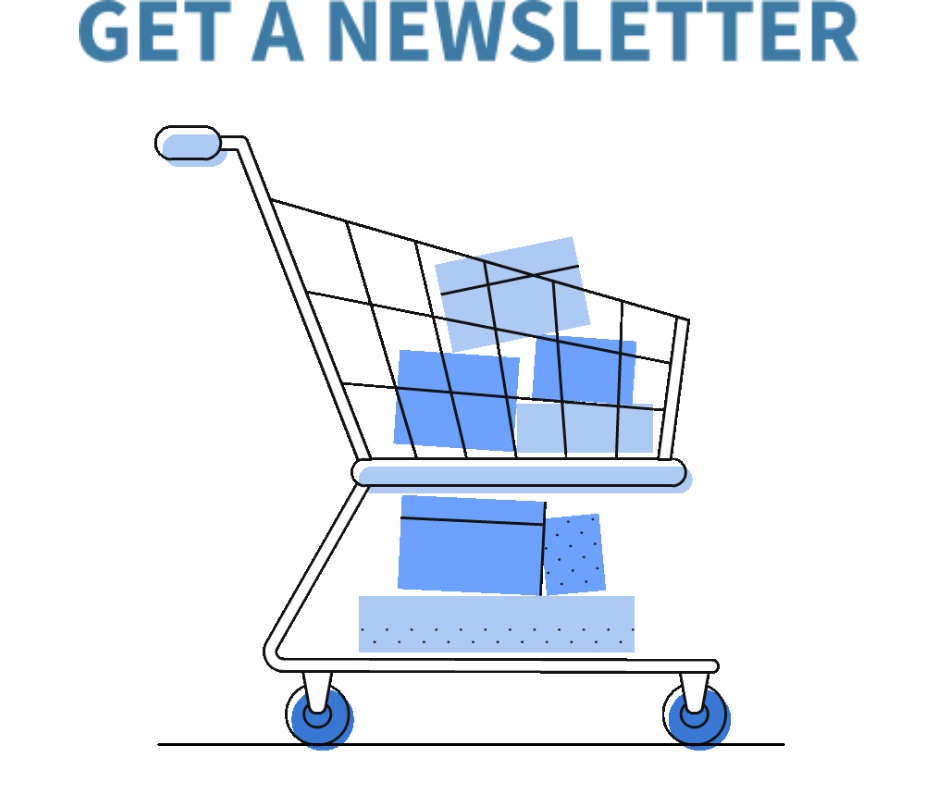
Apparently, almost 75% of shoppers abandon carts – which means merely a quarter ends up making a purchase after visiting your store.
Considering this – and that sending abandoned cart emails results in 10-15% more purchases (and that sending 3 ‘abandoned cart’ emails will result in 69% more purchases still) – you should really implement an abandoned cart B2C email strategy if you have an online store.
What to put in a B2C abandoned cart email sequence?
In order to maximize your conversion rate, you should send three abandoned emails as a rule of thumb.
Each of these three emails should focus on a different purpose:
- Reminder – the first email should be simply a gentle reminder that your potential customer left something in their cart. You can use a sense of humor to make your abandoned cart email more relatable and evoke emotion: “A gremlin is looking at unattended items in your cart”; “Hi again, we see you, John! Have you forgotten something this time?”; “XYZ is almost yours! Woo hoo! Just pay”
- Urgency – if the reminder itself was not enough for your potential customer to make up their mind, adding an element of urgency to it in the second abandoned cart email can help. For example:
- You have XYZ left in your cart. We only have 3 items left in stock!
- Prices on XYZ go up on midnight. Don’t miss the opportunity – complete your purchase now!
- Your cart will expire soon – complete your purchase now and unlock a special offer!
- Incentive – if neither a simple reminder nor an appeal to urgency has helped – your last-ditch abandoned cart effort should be offering an incentive in the last email. Discount vouchers and % off discounts are a great way to take the last chance to convince your audience about it.
How to go about writing your abandoned cart B2C emails?
First of all – there are abandoned carts, and abandoned carts. So – as with any email list – you need to segment your abandoned cart list:
- first-time customers that abandoned carts;
- returning/ regular customers with abandoned carts;
- high-value abandoned carts;
- abandoned carts with high-margin items
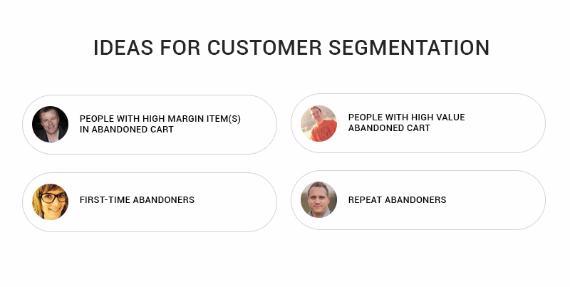
Since – as we mentioned earlier – people prefer personalized messages – your cart abandonment emails need to address their intention – why they abandoned the cart in the first place.
For example, first-time buyers may be concerned about the security of the purchase, while people who abandoned a cart with a high total value – may have been daunted by the total order price. Hence – in your abandoned cart emails, you should refer to these ‘sales objections’ specific to the different groups:
- first-time buyers –> ensure payment security
- returning customers –> establish a foothold to your previous relationship: thank them for their previous purchase and ask whether they were happy with it; offer participation in a loyalty program or offer a discount voucher
- high-value abandoned carts –> give special discount on the entire cart value;
- abandoned carts with high-margin items –> offer the cheapest item 50% cheaper if they buy the high-margin item;
Subject line
The subject line of your abandoned cart email is as critical as the content – after all 47% of people decide whether to open your emails based on the subject line alone.
So – make sure the subject lines of your abandoned cart emails are relevant to the recipient:
- refer to the item they want to purchase
- refer to the stage in their customer journey (are they returning or new customers?)
- make sure you make the purpose of each email clear in the subject line (reminder, urgency, incentive)
- use personalization – refer to the subscriber by name
- use emojis
Of course – to get the subject lines right, you will need to segment your audience first.
Timing
As we mentioned before, you should send the first email in your abandoned cart sequence within an hour of when someone left your site.
What about emails 2 and 3?
Send them on the next day and within 3 days of the attempted purchase respectively.
2. Blog sign-up form/lead magnet download
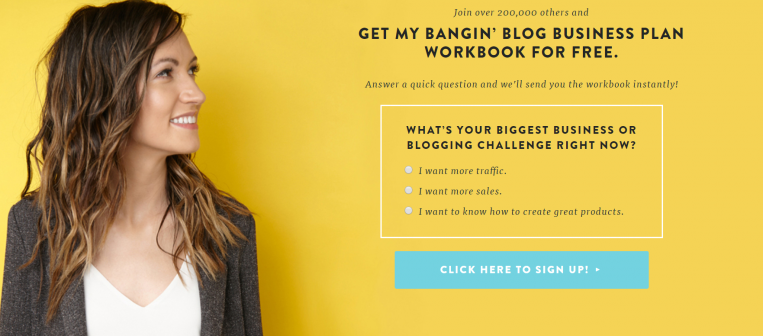
Ok, so this B2C email sequence is actually relatively easy. At least compared to abandoned cart emails .
Here – you can segment your audience by interests pretty much automatically – as the asset, they download immediately indicates their interests.
Same with email signup forms – see what Melyssa Griffin did on her homepage in the hero header. An *exceptionally smart* way to segment your subscribers straight away is to simply *ask them* what they want to receive from you.
The emails you send to the subscribers from your website should refer to what they downloaded and build upon it in a logical way, bringing more value – while at the same time gradually nudging your subscriber towards making a purchase:
- Email 1: Hey John! Thanks for downloading our ‘Ultimate guide to email marketing!’ – we have some free newsletter templates for you as well now!
- Email 2: More newsletter templates + autoresponder ideas
- Email 3: Now let’s collect more subscribers John!
- Email 4: Hey John, great job with collecting subscribers! Upgrade your account now before you hit the free limit and get 10%!
Make sure you give plenty of value for free before you ask for a sale – jab, jab, jab – and only then – right hook.
3. Old customer nurturing campaign
It’s 5 x more difficult and expensive to acquire a new customer than to retain an old one – that’s why customer retention is key.
How to nurture those relationships though?
- Use your newsletters for aftersale customer service – ask your customers if they are happy with their purchase and if they need any help;
- Show value – if you sold them a red dress – send them information on ‘9 ways how you can style your red dress’
- Offer upsells – show them how they can achieve even more value by offering complementary products or services. Again – if you sold them a red dress – then send them ideas for jewelry and accessories they could wear with it.
Subject Lines
- Personalize. Make sure you include your recipient’s name and actually refer to their (professional) relationship with you – e.g. referring back to a previous purchase they made, or specific interests they showed by e.g. downloading a certain lead magnet/ asset;
- Use emojis.Subject lines with emojis increase the open rate by a whopping 56%. This is a staggering number when you consider that only 6.9% of subject lines contain them!
- Use words proven to boost open rates: “secrets”, “e-sales” and “awesome”.
- Avoid the following words: “confirm”, “features” and “upgrade”.
STEP 5: Design matters – designing your B2C newsletters + newsletter templates
How to design a great B2C newsletter?
Here are some general tips (and examples of good practices):
- User personalization in the newsletter text as well
- Have a clear CTA – and use it phrased differently 3 times – it leads to higher click-through rates (Source: Technology of Marketing Conference/ Postfity)
- Use buttons – having a CTA button can contribute to a 28% boost in click-through rates! (source: Campaign Monitor in Backlinko)
- Use your logo and brand colors in every email
- Don’t forget your social sharing buttons
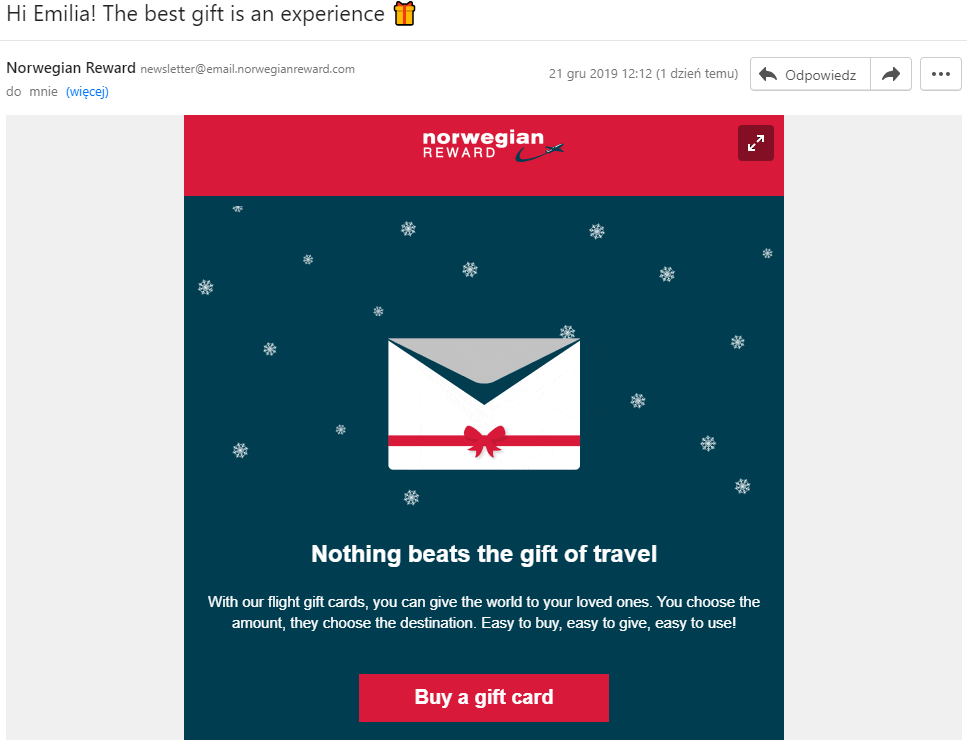
STEP 6: Automate your B2C email campaign with autoresponders
When to send your B2C newsletters?
Preferably every week after your client has signed up for your newsletter or made a purchase.

+ BONUS: B2C newsletter templates
Get started with email marketing
Create beautiful email newsletters for free with Get a Newsletter and reach your subscribers and customers in a heartbeat.
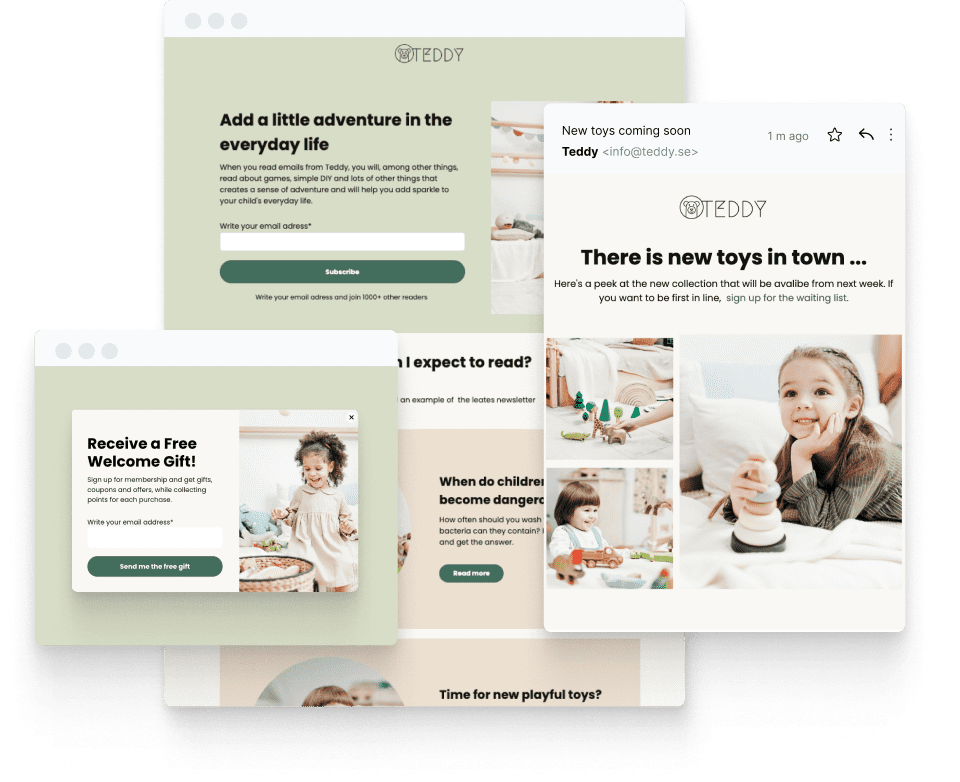
Leave a Reply